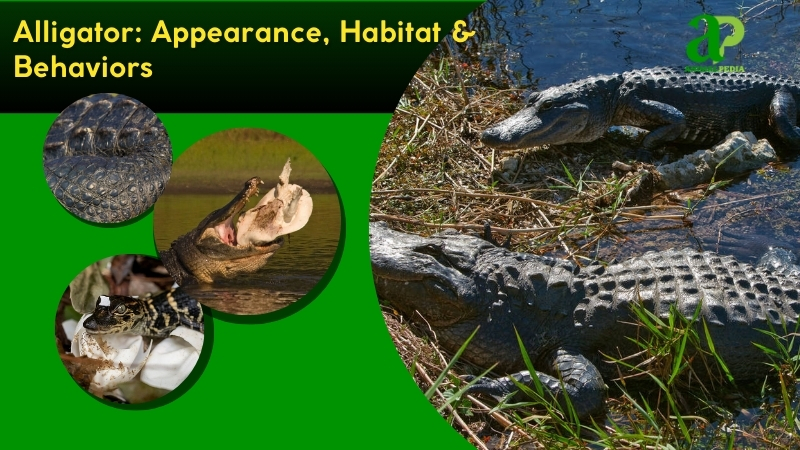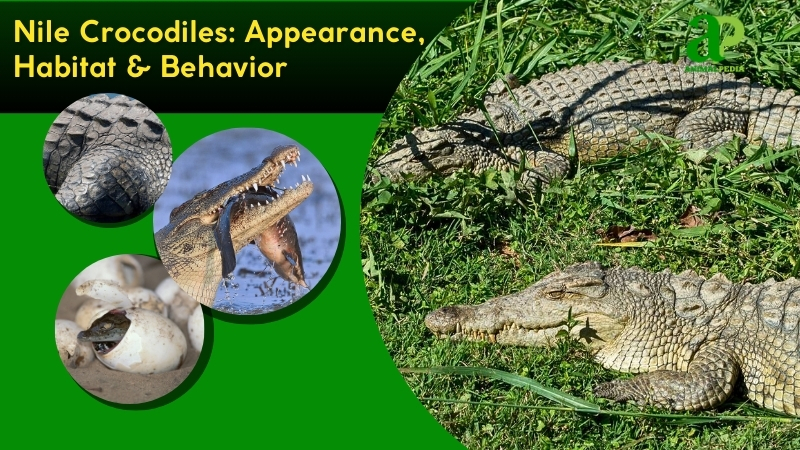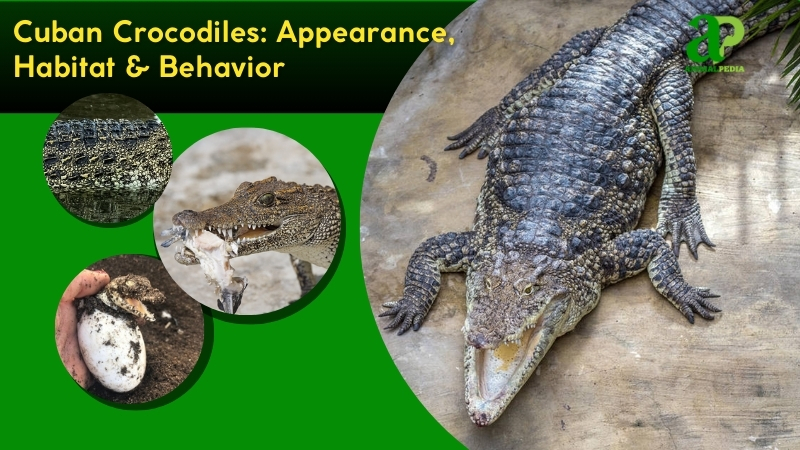Paleosuchus, encompassing Paleosuchus palpebrosus (dwarf caiman) and Paleosuchus trigonatus (smooth-fronted caiman), are diminutive crocodilians distinguished by their compact, heavily armored bodies. They inhabit South America’s Amazon Basin, thriving in the Rio Negro, Madeira River, Essequibo, and Ucayali River systems in Brazil, Bolivia, Guyana, and Peru, respectively. Their defining trait is their small size: 4–6 feet (1.2–1.8 meters) and 13–44 pounds (6–20 kilograms), making them the smallest caiman species. Their robust, bony osteoderms provide exceptional protection in dense forest streams.
Unlike apex predators like black caimans, Paleosuchus are opportunistic carnivores. They hunt nocturnally, targeting insects, crustaceans, small fish, and mammals in shaded, forested waterways. Their diet specializes in hard-shelled prey like crabs, reflecting their smaller, yet powerful jaws. Their terrestrial agility sets them apart, as they often travel 1–2 miles (1.6–3.2 kilometers) nightly on land. Human interactions are rare due to their elusive, shy nature, reducing conflict in remote habitats.
Reproduction occurs during the wet season (May–October). Males emit low-frequency vocalizations and perform head movements to court females, mating in shallow, vegetated waters. Females lay 10–15 eggs, each 0.1 pounds (45 grams), in mound nests constructed from soil and leaves, hidden under forest cover. Incubation lasts 90–100 days, with hatchlings emerging at 6 inches (15 centimeters).
Hatchlings feed on insects and small crustaceans, facing predation from raptors, snakes, and larger fish. Females guard them for 3–6 months, ensuring higher survival. Juveniles grow slowly and reach maturity at 10–12 years. Their lifespan of 20–40 years is shorter than that of larger caimans due to predation pressure and environmental stressors.
This article examines Paleosuchus’ appearance, habitat, predatory behaviors, and reproductive cycle, highlighting their specialized adaptations as small, resilient crocodilians in Amazonian ecosystems and their ecological role in maintaining biodiversity.
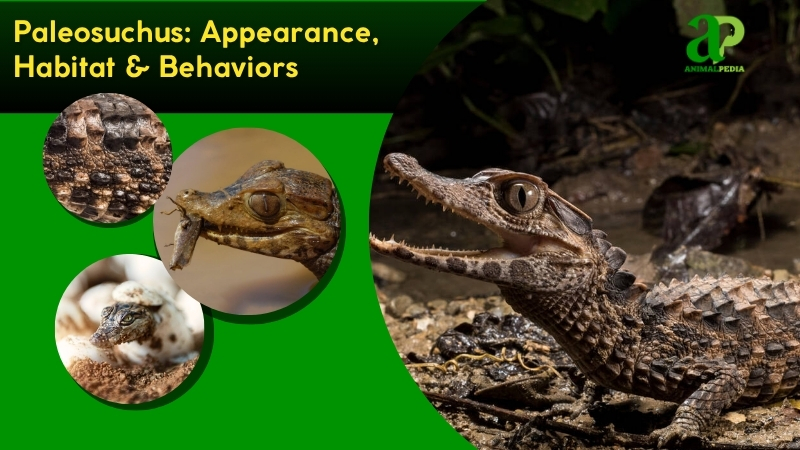
What Do The Paleosuchus Look Like?
Paleosuchus, encompassing Paleosuchus palpebrosus (dwarf caiman) and Paleosuchus trigonatus (smooth-fronted caiman), exhibit compact, cylindrical bodies measuring 4–6 feet (1.2–1.8 meters) and weighing 13–44 pounds (6–20 kilograms).
Their skin, textured with bony osteoderms, is rough and colored dark brown to olive-green, often mottled with faint bands for camouflage in Amazonian forest streams. Key features from head to tail include a broad head with a smooth or bony ridge (P. trigonatus vs. P. palpebrosus), dark eyes with vertical pupils for nocturnal vision, a fixed tongue, a short neck, a rigid body, short limbs with webbed claws enabling 1–2 miles (1.6–3.2 kilometers) of nightly terrestrial movement, and a narrow, tapered tail for efficient swimming (Campos et al., 2016).
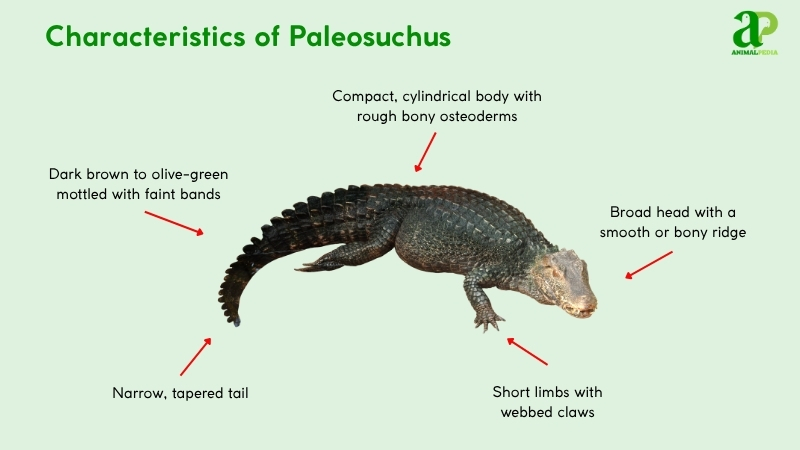
In contrast to Caiman crocodilus, Paleosuchus is notably smaller and more terrestrial, with denser osteoderms that provide enhanced protection. The smoother snout of P. trigonatus and the distinct bony ridge on its head set them apart from other caimans, facilitating species identification.
Their dark, mottled coloration differs from that of the lighter, more uniform Caiman yacare, which optimizes concealment in shaded, forested habitats (Magnusson & Campos, 2019).
How Big Do Paleosuchus Get?
Paleosuchus typically measures 4–5 feet (1.2–1.5 meters) in length and weighs 13–33 pounds (6–15 kilograms). Adult individuals generally attain 4–6 feet (1.2–1.8 meters) from snout to tail, distinguishing them as the smallest crocodilian species.
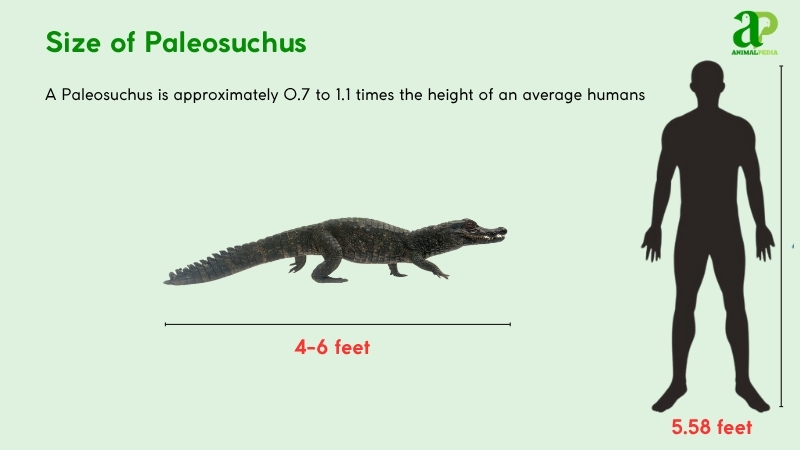
The largest documented Paleosuchus trigonatus, recorded in Brazil’s Rio Purus in 2017, reached 6.6 feet (2 meters) and weighed 44 pounds (20 kilograms) per Journal of Herpetology (Campos et al., 2017).
Males are marginally larger, averaging 5–6 feet (1.5–1.8 meters) and 22–44 pounds (10–20 kilograms), whereas females typically measure 4–5 feet (1.2–1.5 meters) and weigh 13–22 pounds (6–10 kilograms), reflecting subtle sexual dimorphism.
| Trait | Male | Female |
| Length | 5–6 ft (1.5–1.8 m) | 4–5 ft (1.2–1.5 m) |
| Weight | 22–44 lbs (10–20 kg) | 13–22 lbs (6–10 kg) |
What Are The Unique Physical Characteristics Of The Paleosuchus?
Paleosuchus are characterized by their exceptionally small size and heavily ossified osteoderms. Unlike other crocodilians, P. palpebrosus attains a maximum length of 4–6 feet (1.2–1.8 meters), with a distinctively domed skull, and P. trigonatus exhibits a smooth frontal ridge, facilitating species identification.
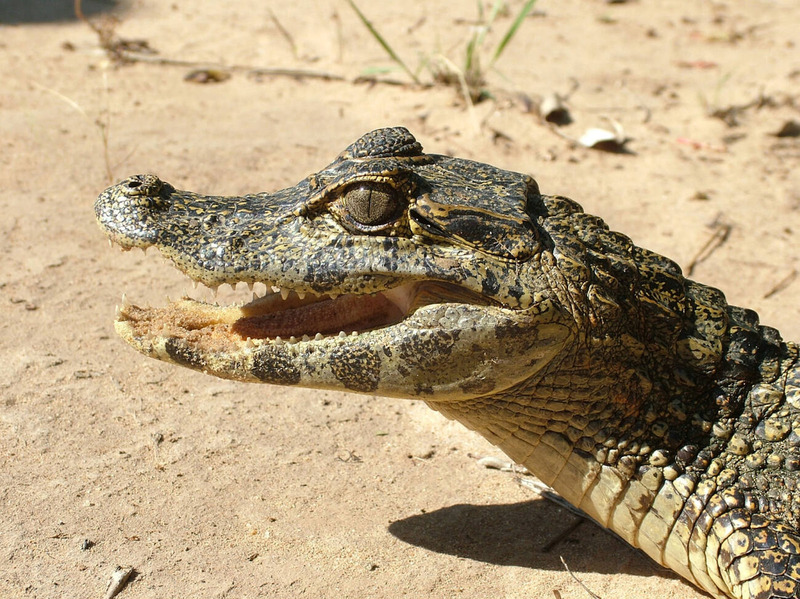
Their osteoderms, covering over 80% of the body, provide unparalleled protection for terrestrial movement in Amazonian forest streams, a feature less pronounced in other caimans. The domed skull of P. palpebrosus enhances bite force for crushing hard-shelled prey like crustaceans, while the smooth ridge of P. trigonatus improves hydrodynamic efficiency.
These adaptations, paired with dark, mottled skin for camouflage, set them apart from larger, less armored species, such as Caiman crocodilus (Magnusson & Campos, 2019).
Paleosuchus, a genus of small crocodilians, is known for its distinctive features and agile nature. While these creatures may be smaller than their better-known relatives, they share many traits characteristic of crocodile species, such as armored bodies and powerful jaws.
How Does Paleosuchus Adapt With Its Unique Features?
Paleosuchus utilizes its small size and dense osteoderms to survive in Amazonian forest streams. Their compact bodies, measuring 4–6 feet (1.2–1.8 meters), allow them to navigate through dense vegetation, while their robust armor shields them against predators like jaguars.
Their senses bolster environmental adaptation. Eyes with vertical pupils enhance low-light vision, facilitating nocturnal hunting. Sensory pits on the snout detect water vibrations, allowing fish to pinpoint their location in murky streams.
Acute hearing via ear flaps identifies approaching threats, enabling timely evasion. A keen olfactory system in the nostrils locates food sources, supporting efficient foraging in complex habitats (Magnusson & Campos, 2019).
Anatomy
Paleosuchus exhibits specialized anatomical systems adapted for life in Amazonian forest streams. Their compact physiology supports their role as agile crocodilians, balancing aquatic and terrestrial demands.
- Respiratory System: Lungs with unidirectional airflow maximize oxygen efficiency. Nostrils on the snout enable breathing while submerged, aiding stealth.
- Circulatory System: A four-chambered heart ensures efficient oxygen distribution throughout the body. Valves adjust blood flow during dives, enhancing aquatic endurance.
- Digestive System: A strong stomach digests crustaceans and fish. Slow metabolism allows weeks without feeding, which suits sparse-prey environments.
- Excretory System: Kidneys excrete uric acid, conserving water. The cloaca manages waste, adapting to fluctuating stream conditions.
- Nervous System: A compact brain processes sensory inputs from the eyes and snout pits. Quick reflexes support precise nocturnal hunting.
Together, these anatomical systems reflect the evolutionary refinement of Paleosuchus for life in narrow, forested waterways. Their ability to navigate both aquatic and terrestrial terrains with stealth and efficiency underscores their adaptive success in complex Amazonian ecosystems.
Where Do Paleosuchus Live?
Paleosuchus are distributed across South America’s Amazon Basin, with significant populations in Brazil’s Rio Negro, Bolivia’s Madeira River, Guyana’s Essequibo, and Peru’s Ucayali River. They primarily inhabit forested streams and flooded savannas.
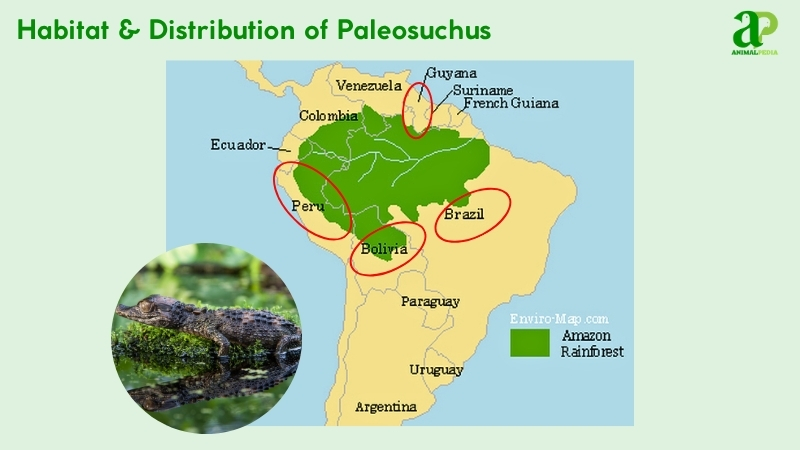
Their living environment features warm temperatures (77–86°F/25–30°C) and high humidity, with dense vegetation providing cover. Shallow, slow-moving waters offer abundant prey, such as crustaceans, and facilitate ambush hunting, perfectly suiting their small size and terrestrial agility. These conditions support their nocturnal and elusive behavior (Magnusson & Campos, 2019).
Fossil evidence suggests that Paleosuchus has occupied these regions since the Miocene, approximately 23 million years ago, without evidence of migratory patterns. Their presence in stable, prey-rich forest streams is well documented in ecological research, which explains their persistent distribution (Campos et al., 2016).
How Do Seasonal Changes Affect Their Behavior?
Paleosuchus exhibits behavioral shifts driven by the Amazon Basin’s wet and dry seasons. These adaptations ensure their survival in dynamic forested stream habitats.
- Wet Season (May–October): Flooded streams enhance prey availability, prompting active hunting of fish and crustaceans. Females construct mound nests and lay eggs, vigilant to protect them.
- Dry Season (November–April): Shrinking water levels restrict movement to isolated pools, reducing foraging. They bask frequently to regulate temperature and conserve energy, feeding opportunistically (Campos et al., 2016).
These seasonal shifts reflect Paleosuchus’ adaptability to changing conditions. By modifying their behavior in response to water levels, they maintain their role in the ecosystem and improve their chances of survival amid environmental fluctuations.
What Is The Behavior Of Paleosuchus?
Paleosuchus displays elusive behaviors tailored to Amazonian forest streams. These small crocodilians are nocturnal and solitary, prioritizing stealth and energy conservation.
- Feeding Habits: They hunt crustaceans and fish at night. Their diet adapts to prey availability.
- Bite & Venomous: Their 200-pound (90-kilogram) bite crushes shells. They lack venom and rely on jaw strength.
- Daily Routines and Movements: Nocturnal; they rest by day and move 1–2 miles (1.6–3.2 kilometers) nightly. Basking regulates temperature.
- Locomotion: They swim at 5 mph (8 km/h) using their tails. On land, they crawl agilely.
- Social Structures: Solitary, they interact only for mating. Females guard hatchlings briefly.
- Communication: Low grunts signal mates. Head movements mark territory.
Together, these behaviors reveal a species finely tuned to life in dense, aquatic forest habitats. From silent movement to strategic feeding and minimal social interaction, Paleosuchus exemplifies survival through stealth, strength, and solitary efficiency.
What Do Paleosuchus Eat?
Paleosuchus primarily eats crustaceans, such as crabs, and small fish. Their small size and elusive behavior make human attacks unlikely. They crush prey with a 200-pound (90-kilogram) bite and swallow small items whole. Oversized prey may cause choking, often leading to regurgitation or abandonment (Campos et al., 2017).
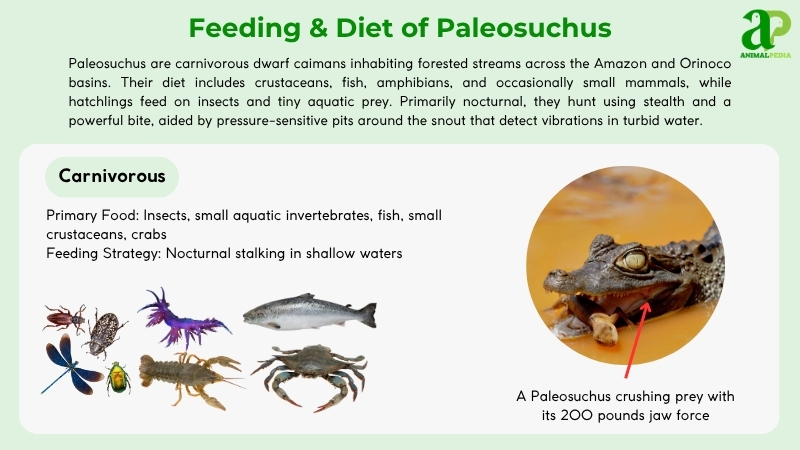
- Diet by Age:
Hatchlings (<1 foot/0.3 meters) feed on insects and small crustaceans due to limited jaw strength. Juveniles target larger fish, while adults (>4 feet/1.2 meters) prey on crabs and small mammals, leveraging enhanced bite force.
- Diet by Gender:
Males and females share similar diets, mainly crustaceans and fish. However, larger males may occasionally pursue larger prey, such as rodents or amphibians, due to their size advantage. This slight dietary variation helps reduce competition, especially during mating seasons when territory overlap increases.
- Diet by Seasons:
Seasonal fluctuations in water levels significantly shape feeding behavior. In the wet season, abundant fish dominate their diet. During the dry season, they adapt by feeding on terrestrial insects and stranded crabs in shrinking streams, showcasing flexibility in resource-scarce conditions.
How Do Paleosuchus Hunt Their Prey?
Paleosuchus rely on a mix of patience, stealth, and cunning to catch their prey effectively. These small crocodilians are skilled hunters in their natural habitat.
They often wait quietly in the water, motionless, blending seamlessly with their environment until the perfect moment to strike arrives. With their streamlined bodies and sharp teeth, Paleosuchus can swiftly grab their prey with precision.
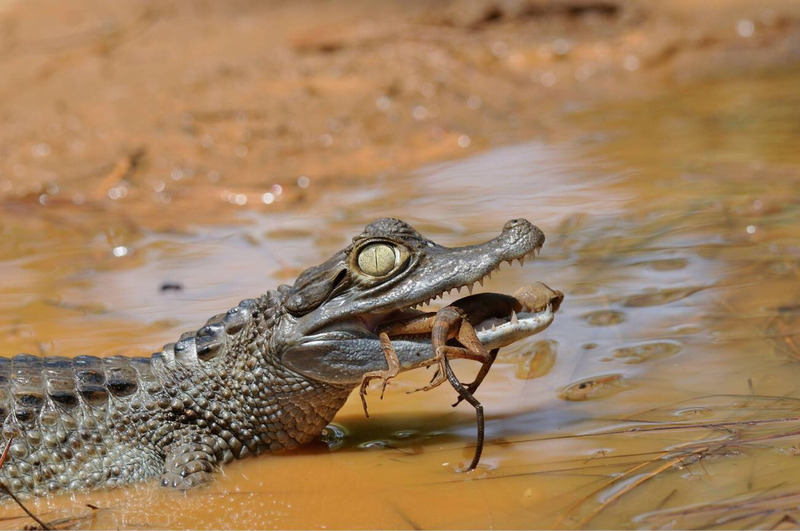
Their hunting approach involves meticulous observation and calculated actions. Paleosuchus uses its sharp senses to detect even the slightest movements in the water or on land. Once they locate their prey, they move stealthily and slowly to avoid alerting their target.
When the time is right, they utilize their speed and agility, lunging forward to capture their meal.
Paleosuchus are adaptable hunters, adjusting their tactics based on the prey available. Whether they’re hunting fish, insects, or small mammals, these intelligent creatures modify their strategies to ensure a successful catch. With its unique blend of patience, stealth, and cunning, Paleosuchus proves to be a formidable predator in its ecosystem.
Are Paleosuchus Venomous?
It’s important to note that Paleosuchus doesn’t possess venom. These small caimans rely on their strong jaws, sharp teeth, and exceptional hunting abilities to capture their prey.
Preferring to ambush their targets, Paleosuchus patiently wait for the right moment to strike at fish, crustaceans, and small mammals with impressive speed and precision, both in water and on land.
Despite their fearsome appearance, Paleosuchus are rather timid and tend to avoid conflicts with larger animals. They’re most active at night, using the cover of darkness to forage and explore their environment.
Observing these unique behaviors in the wild offers a fascinating glimpse into the adaptability and resilience of these creatures.
When is Paleosuchus Most Active During The Day?
Paleosuchus, or dwarf caimans, are most active at night when they search for food in the dark. During the day, these small crocodilians prefer to rest in shaded areas near water bodies to stay cool and conserve energy for their nighttime pursuits. This behavior helps them avoid the hot daytime temperatures and reduces the chance of encountering predators.
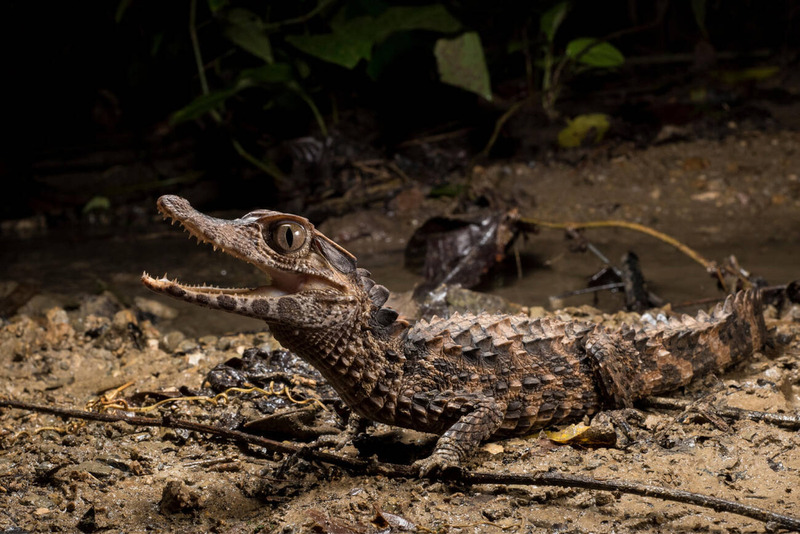
If you happen upon a Paleosuchus during the day, you may observe its calm demeanor as it basks in the sun or lies still by the water. Despite their apparent stillness, these creatures are vigilant and prepared to react to any threats or opportunities that arise.
While they may not be as active during the day, their nocturnal activities showcase another side of their intriguing behavior.
In essence, Paleosuchus exhibits a unique rhythm between day and night, balancing rest and activity to survive in its environment. These creatures’ adaptation to their surroundings highlights the fascinating ways in which animals adjust their behavior for optimal survival.
How Do Paleosuchus Move On Land And Water?
Paleosuchus demonstrates versatility by effortlessly moving on both land and in water. On land, these creatures showcase agile movements, using their sturdy bodies to crawl swiftly and precisely. Their powerful limbs help propel them forward, allowing for moments of rest or sunbathing.
In water, Paleosuchus excels as a proficient swimmer, gracefully navigating its aquatic surroundings. Their streamlined bodies and webbed feet facilitate swift movements, whether they’re hunting for prey or exploring their watery habitats. Observing these ancient reptiles glide through the water with grace and strength is truly captivating.
With a sense of freedom and confidence, Paleosuchus demonstrates adaptability and resilience across diverse environments. Their ability to thrive on land and in water highlights their unique characteristics and survival skills.
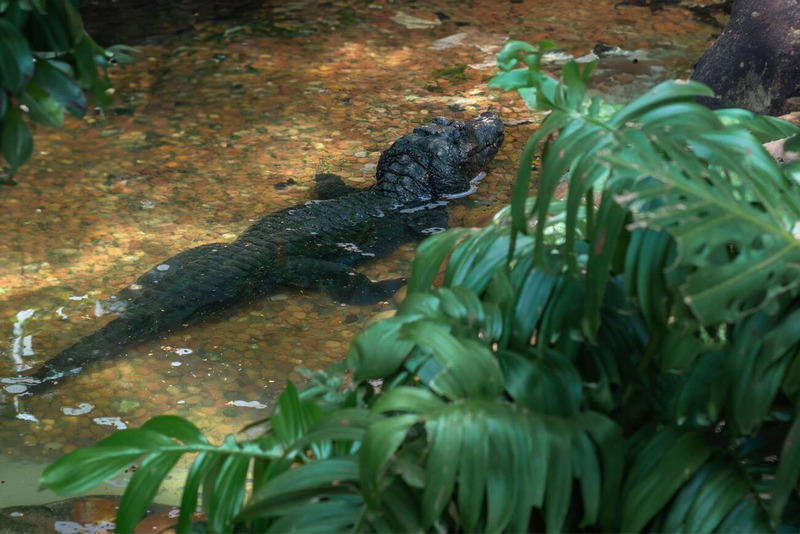
Do Paleosuchus Live Alone Or In Groups?
Paleosuchus, like other small crocodilian species, typically leads a solitary lifestyle, choosing to live alone rather than in groups. They value their independence, preferring to wander their habitats alone without the need for constant companions. Living independently allows them the freedom to explore and hunt at their own pace, without the constraints of group dynamics.
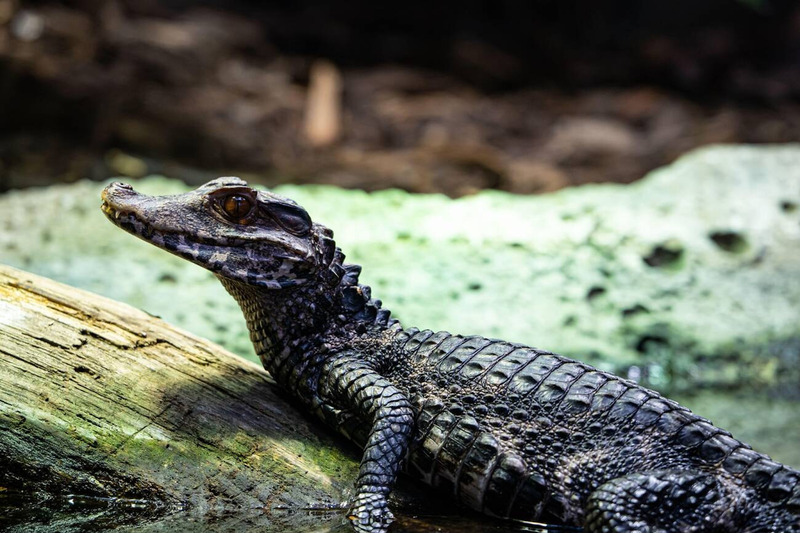
Although Paleosuchus generally prefers solitude, they can interact peacefully with others when necessary, such as during breeding seasons or during chance encounters. This solitary existence not only lets them enjoy peace and quiet but also helps them avoid competition for resources, ensuring they can secure enough food to thrive in their environment. By living solo, these crocodilians can make the most of their surroundings without having to share their meals or shelter with others.
So, if you should happen upon a Paleosuchus in the wild, remember that they likely value their alone time just as much as you do!
“If you ever come across a Paleosuchus in the wild, remember that they probably enjoy their alone time just as much as you do!”
How Do Paleosuchus Communicate With Each Other?
While Paleosuchus typically leads a solitary life, they do have subtle ways of communicating with each other when needed. These dwarf caimans may not rely on group communication, but they use gentle head bobs and body postures to establish boundaries and convey intentions when encountering another individual.
By using non-verbal cues like changing body coloration or displaying specific patterns, they express their emotions and intentions, helping them understand each other’s moods and avoid conflicts. Through these silent interactions, Paleosuchus can peacefully coexist in their habitats, showing respect for each other’s space and needs.
This communication style allows them to navigate their shared environments harmoniously without unnecessary confrontations.
How Do Paleosuchus Reproduce?
Paleosuchus reproduces sexually through internal fertilization, optimizing offspring viability in Amazonian forest streams. Breeding commences in the wet season (May–October), with males producing low-frequency grunts and head movements to court females. Females respond with softer vocalizations, initiating nuzzling and mating in shallow, vegetated waters.
From June to July, females lay 10–15 eggs, each weighing approximately 0.1 pounds (45 grams), in mound nests constructed from soil and leaves, concealed under forest cover. Females vigilantly guard against predators like snakes and birds, while males disperse post-mating. Flooding events, such as those in Bolivia’s Beni River in 2016, have disrupted egg-laying, reducing clutch sizes.
Eggs incubate for 90–100 days, hatching between September and October. Hatchlings, measuring 6 inches (15 centimeters), feed on insects and small crustaceans, growing approximately 4 inches (10 centimeters) per year. Maternal protection lasts 3–6 months, with juveniles reaching sexual maturity at 10–12 years.
Paleosuchus live 20–40 years, with their life cycle heavily influenced by habitat stability. Deforestation and pollution pose significant threats to reproductive success, highlighting the need (Campos et al., 2017).
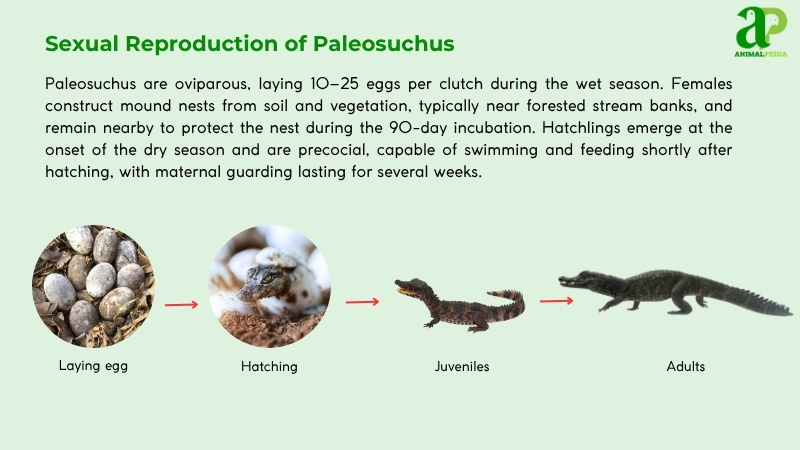
How Long Do Paleosuchus Live?
Paleosuchus live 20–40 years, shaped by predation and environmental conditions in Amazonian forest streams. Juveniles face high mortality from predators like birds and snakes, while adults are robust.
Both males and females average 25–30 years of age, with no notable sex differences. Captive individuals may live up to 45 years due to fewer threats. Habitat loss, particularly deforestation, reduces lifespan, underscoring the need for conservation efforts. Their slower metabolism and reclusive behavior likely contribute to their longevity compared to other small reptiles (Campos & Magnusson, 2017).
What Are The Threats Or Predators That Paleosuchus Face Today?
Paleosuchus face habitat loss, pollution, and climate change, endangering their Amazonian stream populations. Juveniles are susceptible to predators, while human activities exacerbate threats, underscoring the need for conservation.
- Habitat Loss: Deforestation eliminates 20% of Amazonian streams, reducing prey availability and nesting sites, constraining population expansion.
- Pollution: Pesticide runoff in rivers compromises egg viability, with 10% of clutches failing in contaminated zones.
- Climate Change: Irregular rainfall patterns disrupt breeding cycles, decreasing hatchling survival by 15% during unpredictable wet seasons.
Predators such as jaguars, anacondas, and raptors primarily target hatchlings (<1 foot/0.3 meters). Adults, protected by dense osteoderms, encounter few natural threats.
Human activities significantly impact Paleosuchus. Logging and mining fragment habitats, and 30% of Amazonian waterways have been degraded since 2015.
Mercury from gold mining in Guyana’s Essequibo River reduced populations by 12%, while agricultural runoff in Bolivia’s Madeira River impairs reproduction, contributing to a 10% population decline in affected areas (Campos et al., 2017).
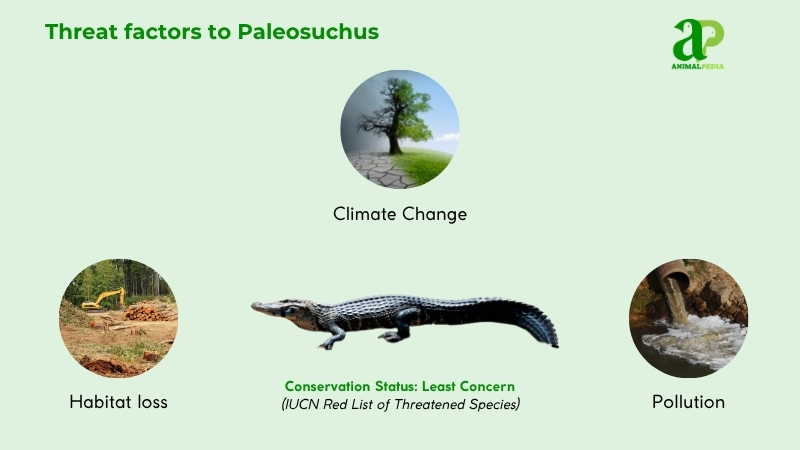
Is Paleosuchus Endangered?
Paleosuchus are currently classified as Least Concern on the IUCN Red List, indicating that their populations are stable and not facing any immediate threat of extinction.
The IUCN classifies both species as Least Concern, reflecting their extensive range across South America’s Amazon Basin and stable population trends. Their adaptability to forested streams mitigates impacts from localized deforestation and pollution. Conservation measures, such as protected areas in Brazil’s Rio Negro and Peru’s Ucayali, bolster their numbers.
Population data indicate Paleosuchus palpebrosus has 100,000–200,000 individuals, concentrated in Brazil, Peru, and Guyana, according to 2016 field surveys.
Paleosuchus trigonatus maintains 50,000–100,000, primarily in Bolivia’s Madeira River. Despite stable overall numbers, gold mining in Guyana’s Essequibo River caused a 12% local decline in 2018, highlighting ongoing threats (Campos et al., 2017).
What Conservation Efforts Are Underway?
Paleosuchus are supported by targeted conservation in the Amazon Basin, driven by the Amazon Conservation Association and the IUCN Crocodile Specialist Group. Since 2015, Brazil’s Mamirauá Sustainable Development Reserve has monitored populations, documenting 2,000 caimans in 2022.
Legal protections include Brazil’s Federal Law 5197 (1967), prohibiting wildlife hunting, and CITES Appendix II, limiting trade in caiman skins to curb poaching. Peru’s Decree 004-2016 (2016) bans mining in critical habitats, such as the Ucayali River, thereby reducing pollution impacts on breeding sites.
Bolivia’s Beni Biological Station launched a breeding program in 2018, releasing 50 caimans by 2021, with 70% reaching adulthood. Peru’s Pacaya-Samiria Reserve safeguarded 200 nests from 2017 to 2020, increasing hatchling survival by 25%. In Guyana’s Essequibo River, community patrols since 2019 have curbed poaching, stabilizing 1,500 caimans, showcasing effective local conservation (Campos et al., 2016).
Frequently Asked Questions
Are Paleosuchus Dangerous to Humans?
Yes, they can be dangerous. Be cautious of their stealthy nature near water. Understand their potential threat in the wild. Take caution when approaching Paleosuchus due to their sharp teeth and strong bite.
Do Paleosuchus Have Any Unique Adaptations?
Yes, paleosuchus possesses distinctive adaptations. Their streamlined bodies aid in stealth underwater, while camouflaged scales provide effective concealment. With powerful jaws for hunting and armored skin to deter threats, these adaptations serve them well in their environment.
What Is the Population Status of the Paleosuchus Species?
You should take a look at the critical situation of the population status of the Paleosuchus species. Understanding the numbers and trends is necessary for their survival. Conservation efforts need your support to secure their future.
Are There Any Conservation Efforts for Paleosuchus?
Yes, there are conservation efforts for the Paleosuchus species. Organizations work to protect their habitats, monitor populations, and raise awareness. You can get involved by supporting these groups, spreading the word, and practicing responsible, eco-friendly habits.
Can Paleosuchus Species Be Kept as Pets?
You shouldn’t keep Paleosuchus species as pets. They require specialized care and pose risks due to their wild nature. Respect their habitat and support conservation efforts to protect these unique creatures in their natural environment.
Conclusion
To sum up, Paleosuchus, the enthralling dwarf caimans, are truly creatures with their distinctive physical attributes, cunning hunting methods, and solitary behavior. With their broad, flat snouts and speckled brown coloration, these adept hunters flourish in murky waters, hunting fish and small mammals. In South America, these species face challenges from habitat destruction and predators. All in all, Paleosuchus is a mesmerizing group of reptiles that fascinates scientists and nature enthusiasts alike.





